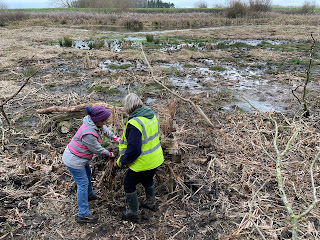Festive season approaches
North lagoon undergoes a facelift
The reserve at Tophill Low surrounds the clean water
treatment works, with south and north lagoon receiving some of the excess
filtered water. At the moment, north lagoon has been drained and in the new
year it will start to receive water again and fill up. Now is the time to do
habitat work to make sure that once the water level returns then so will the
wildlife. Our fantastic volunteer team have been busy cutting down willows,
building a new kingfisher nesting site, installing new kingfisher feeding
perches and designing and positioning duck nesting platforms, along with
weaving a willow screen so that as visitors walk past, they do not disturb the
wildlife. Autumn and winter are the busiest times for habitat management on the
reserve so it’s very much all go, and we would like to thank the volunteers for
all their efforts throughout the year as we really couldn’t create such varied
habitats without their help.
New kingfisher nesting hole outside north lagoon hide
Building duck nesting platforms on north lagoon
Visitors with a keen interest in photography were invited to
enter our annual photography competition, which showcases the wildlife that
uses the reserve. The exhibition of all the entries can be viewed over the
festive season, which is being held in the classroom, downstairs in the main
reception building. We are asking people to vote for their own overall winning
photograph, the public vote. This image will then be used on our membership
cards for 2025. Please do come and visit the exhibition and cast your vote, and
perhaps be inspired to enter next year. The prize for the winners of each
category is a full years membership.
Photo exhibition on display in the Holt
As visitors return via the nature trail route you may now notice that there is a second polytunnel in situ. This is yet another venture for the reserve and the wider Yorkshire Water biodiversity team. This new polytunnel will be set up and dedicated to growing on sphagnum moss, ready for replanting the many upland areas that Yorkshire Water owns and manages as their water catchment areas, mostly situated in the west of the county. So rather than relying on other sources for this valuable plant to restore upland areas, helping to store more carbon and soak up more water, keeping water back from areas at risk of flooding, we will be growing it ourselves here at Tophill Low. Exciting times. If any visitors would like more information about our plant propagation scheme or indeed want to be involved please talk to one of the wardens or our team of volunteers.
New sphagnum polytunnel
The wildfowl on the reserve at the moment looks stunning as
the male ducks look splendid coming into their breeding season. Male goldeneyes
and shovelers were seen yesterday displaying in front of east hide, which
overlooks D reservoir. Males will pair up as soon as they can before heading
back to their breeding grounds, look out for the goldeneyes throwing back their
heads onto their backs to impress the females and compete with other males. The
male shovelers put all their energies into pushing their beaks along, just
under the surface of the water, stretching out their necks, in front of the
females to entice them. Another visitor on D reservoir, which was blown inland from
the east coast after the recent storms is a black throated diver. These birds
are usually found in small numbers along the coast during the winter months,
having bred further north in the sea lochs of northern Scotland. On the sea
they are hard to find and difficult to view so it is a delight to be able to
have the opportunity of seeing this bird in front of the main reception hide.
Look out for a bird that is similar in shape, size and colour to a cormorant
but has a much ‘deeper’ body, whiter throat and its bill is broader and dagger
like, helping it to feed on the reservoir fish!

Photo by Lee Johnson
Also on the reserve is the
return of a male smew, a smart white and black, small, diving duck which has
been frequenting the Watton nature reserve part of Tophill, but occasionally
seen feeding on D reservoir. In amongst the hundreds of shoveler, teal, tufted duck, goldeneyes and pochard there is a pair of red crested pochards.The males have a bright red bill and a stunning set of orangey red head feathers, whereas the female, like most ducks have a more subtle plumage; sexual dimorphism is typical in duck species. Elsewhere cattle egrets are becoming a regular sighting feeding in around the goats on north scrub and Hempholme meadow, so too, great white egrets, two often being seen along the riverbank. Visitors have been lucky enough to spot Jack snipe from south marsh west hide, usually right in front of the hide! Another exciting newcomer to the reserve has been several sightings of bearded tits feeding on the reed mace on the southern marshes.
Smew by Margaret Boyd
If you are planning to visit the reserve over the festive
season, the reserve is open from 9am to 5pm, every day except Christmas Day and
Boxing Day. Admission is £3.50 for adults, £2.50 concessions, £1.50 for
children. Please note there are no refreshment facilities and dogs are not
allowed.
Best wishes to all our volunteers and visitors for a peaceful Christmas and a joyful new year
From
Margaret, Richard and Amy









































.JPG)























